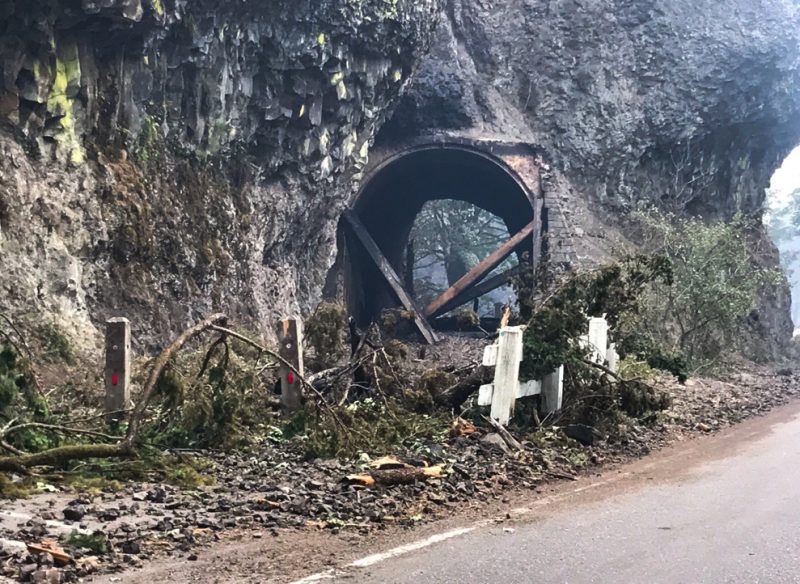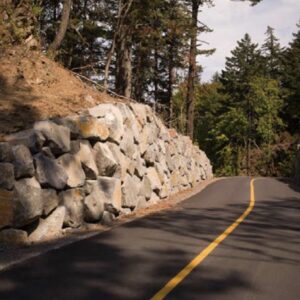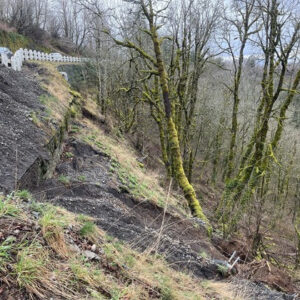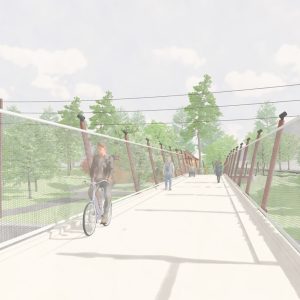
(Photo: ODOT)
The Eagle Creek Fire is still raging in the Gorge and we’ve been reaching out to sources to find out how much impact it has had on the Historic Columbia River Highway and State Trail. Just one year ago we joined a big group of riders and dignitaries for a triumphant centennial celebration of the legendary road. And today it feels like it’ll be another hundred years before things are back to normal.
The good news is not all has been lost. Reports yesterday from fire officials were heartening. But what about those pictures of our dear Oneonta Tunnel engulfed in flames?! We’ve been as eager as you to know more.
This morning I heard back from Kristen Stallman, the outgoing Columbia River Gorge National Scenic Area Coordinator for the Oregon Department of Transportation. Stallman has worked on the Historic Highway project for years and her connection to it transcends her job title. Here’s what she had to say about where things stand today (emphases mine):
As you can imagine we have had some challenging days around here. Courageous folks including the ODOT maintenance crews are working really hard to protect our beautiful Historic Columbia River Highway and the amazing investments that have been made to the Historic Columbia River Highway State Trail over the past thirty years. For now we are in a wait and see pattern. Hopefully mother nature cooperates. We really don’t know too much but here are some updates.
I think I may have seen the same photos of the Oneonta Tunnel as you did. The image leaves a pit in my stomach. The wood liner was primarily cosmetic, however, we will need to assess any heat-related damage to the structural concrete under the wood once it is safe to visit the site.
A major concern after the fire crisis is under control will be the integrity of the roadway once the rain starts again this winter. The slopes will be unstable. Trees and vegetation that held the rocks and steep slopes together are now gone and may be a recipe for more landslides and extensive rock fall. The Historic Highway may be closed for several weeks following the incident.
Advertisement
ODOT and our partners (Multnomah County, US Forest Service, and Oregon Parks and Recreation Department) were excited to kick off the Historic Columbia River Highway Congestion Mitigation and Safety Plan this month. This is a great opportunity to reimagine how visitors will access the Columbia River Gorge focusing on the scenic and much-loved segment between Portland Women’s’ Forum to Ainsworth (Vista House and Multnomah Falls). We call this segment the “waterfall corridor” and it is the most congested segment along the Historic Highway. This is also the segment most impacted by the fire.
Again, we will be meeting in the coming days and weeks to determine how to move forward. The good news is we collected our parking data and bicycle and pedestrian counts the weekend prior to the fire. We are hopeful that the tube counters were not damaged.
The Columbia Gorge Express will not be running this weekend on account of the fire. We have had a busy summer so far exceeding last years’ numbers.
So far the new trail segments under construction east of Wyeth are OK. The contractors have pulled out their equipment and construction has halted. They were working on the next connection of trail between Wyeth and Lindsey Creek. Fingers crossed we can continue construction soon. This will be an amazing section of the trail once it is complete (Spring 2019). The new trail will include safe passage around Shellrock Mountain, beautiful new structures inspired by the historic bridges and rare opportunities to pull the trail away from the Interstate and get on some old pavement segments.
The work on Mitchell Point has also started. We are working on the geotechnical investigations to help us figure out the condition of the rock so the engineers can better evaluate the crossing alternatives. The alternatives include various tunnels, bridges and using the existing ledges for the trail surface. The Historic Columbia River Highway Advisory Committee will be making recommendations of their preferred alternative this coming spring.
We are making great progress but it is important to recognize the trail is not completely funded. We still have some challenging trail segments to fund west of Hood River and east of Viento State Park. We have made tremendous progress and hopefully, mother nature cooperates.
Let’s all hope for the best.
-Kristen Stallman
Strategic Policy Advisor
Oregon Department of Transportation/Region 1
Thank you Kristen. And thank you ODOT for your work on the fire and for making this project such a high priority. We stand ready to help in any way we can to complete the Historic Highway and bring it back to the full splendor of its pre-fire state as soon as possible.
— Jonathan Maus: (503) 706-8804, @jonathan_maus on Twitter and jonathan@bikeportland.org
Never miss a story. Sign-up for the daily BP Headlines email.
BikePortland needs your support.






Thanks for reading.
BikePortland has served this community with independent community journalism since 2005. We rely on subscriptions from readers like you to survive. Your financial support is vital in keeping this valuable resource alive and well.
Please subscribe today to strengthen and expand our work.
sad
It’s a perfect time to close HCRH to cars. At least to through traffic and the Multnomah Falls section.
Why not a toll booth and circulator bus terminal in Corbett? Locals would get lighter traffic and the modest economic boost of that direct investment, then the captive market. The captive market, i.e. tourists, get a secure Park & Ride, an information center with guides to sightseeing and trail safety, and the ability to abbreviate certain hikes. Seems like a win-win.
What about a one-way system only? With a two-way separated contraflow bike/ped lane? (think Naito).
Much of the traffic is heading eastbound anyway. It would still allow access to the Gorge by car, and make biking and walking a million times safer by giving half the roadway over to non-vehicular traffic.
This seems like a no-brainer to me.
The BIG challenge is erradicating parking at Multnomah Falls. If you remove parking, people WILL find other ways to get there (ie bus).
Or hey, here’s a crazy idea, maybe charge money for the parking based on demand? That would encourage a lot more people to take the bus or ride out, or just check out some of the other destinations.
I like the one-way idea. It’s true that most people drive east, stop at various places, then drive back on I-84.
This is what they do in Acadia National Park. The formerly 2-way road is now 1-way with parking allowed on the right side.
I rode out to Multnomah Falls a few weeks ago, and after pondering for few moments over a PB&J, I figured that since it was just a short hop out to Cascade Locks, it was time for me to check out the ‘new’ trail.
I’m really glad that I did that now.
Tentative good news about Oneonta, I figured most of the work to reopen it before was debris removal and rock stabilization, and that the liner that burned was mostly aesthetic. It is also just a (fun) alternate to the road there, so not an access blocker. Hopefully signs about the rest of the road. Standing by to see what volunteer and fundraising efforts may be needed to reach the original goal. Also, just helping to replant the devastated areas like our grandparents did after the Tillamook burn, though as a dynamic ecosystem this time, not a monoculture that has left the coast range less diverse than before.
We don’t need to re-plant anything. Forest are pretty good at coming back on their own. Natural regen is more complex and more interesting than planted forests. Nobody ever replanted most of the giant and intense 1902 Yacolt burn, and yet somehow there’s a forest there now (except where the Washington DNR, US Forest Service, and private landowners have cut down the burn regen). Anyone who’s ever been to Siouxon creek or to the Trapper Creek area on the Gifford Pinchot has seen Yacolt burn forest.
First images here and there from within the Eagle Creek burn perimeter suggest it burned with moderate intensity over quite a lot of the area, staying out of tree crowns and just burning through on the ground. I think the natural landscape will be just fine.
Recreational infrastructure, on the other hand, could be kind of a mess. Winter debris flows, snags coming down, wooden bridges destroyed. The Oneonta tunnel pics kind of sum it up: fixing the infrastructure will take a while and cost some money, but the landscape is fine. Yeah, there will be some areas of 100% mortality that we will lament for a few years until we get used to them and they green up. But they’re not devastated and they’re not destroyed.
Not the end of the world. Enough hyperbole. It’ll be fine.
The forest in the Eagle Creek area will be fine. The fortunate thing for this area’s recovery, is that it’s not timberland subject to logging, and particularly not commercial timberland subject to replanting or lumber salvage according to the harsh realities of the market. As was the forest burned in the Tillamook Burn which was a huge area. Not exactly sure, but I think it was activity related to logging that started that burn.
And the burn wasn’t just one fire, one year either, but a succession of massive fires over a period of ten or fifteen years, I think. All of which helped some to evolve the philosophy of absolute fire suppression, which contrary to common logic at the time, led to the accumulation over years, of brush that becomes fuel that lightening loves to play with. Probably out of print, but there’s a nice little book about the Tillamook Burn, published by Timber Press. Possibly available in used book stores.
Eagle Creek forests will come back fresh and new, and I think many people are going to find watching that recovery, a good experience.
The Tillamook Burn was a completely different situation. It devastated the forest and actually destroyed the cones that would normally be needed to regenerate naturally. This fire in the Gorge is more of a normal fire, where dry underbrush and some of the trees burn, but plenty more are still alive and capable of reproducing. The fire may actually help lead to more diversity by opening up new spaces and opportunities.
I was planning on riding this over the weekend with some friends… 🙁
As a tour guide, I bring groups by bus to the Falls on Hwy 30 weekly. These are people who have traveled from far over to an area most have never been before and all are moved and enthralled by the experience we deliver. Closing the road to cars and/or buses would eliminate the chance for certain folks (my people are probably not going to stay extra days and rent cars, nor take more than cursory hikes) to truly experience what we love here. Half of travel is education, that would be lost by disallowed motorized vehicles on Hwy 30.
A good compromise would be close the HCRH to vehicles with washington state license plates as they are more likely to be filled with illegal fireworks and careless yahoos.
Really? And you don’t think Oregonians can be stupid? Comments like yours don’t help anybody.
Most attractions and trailheads either have alternate access from I84 or are close enough to an 84 exit that the solution could be to end through access all the way from Corbett to Dodson. Greenway style diverters at Crown Point and between Multnomah and Horsetail falls to create stretches of car free highway that would reduce traffic overall. I don’t mean to sound elitist, but easy car access and themepark-like crowds are what is killing all our unspoilt natural treasures and likely contributed to why bored teenage boys were out there messing with smoke bombs in the first place.
That’s sort of my point- close it to through traffic. People can still get to trailheads, buses can still get to I-84 parking.
I haven’t seen anyone seriously advocating banning buses from the HCRH. It’s the car traffic that causes trouble. I really like Champs’ suggestion above for local-access cars and buses only.
And in any case, you could get a private bus to Multnomah Falls via I-84 and avoid the narrow and winding sections of HCRH.
Please, you’re making money off of a public resource, not building awareness or educating the masses.
Not sure what the problem is. Would you prefer these people took private vehicles? How is a privately managed service inherently worse than a publicly managed one?
Even if the highway were closed to all motorized traffic except approved shuttles, my guess is that even the majority of readers of this bike blog would not pedal out — i.e. people would be using fossil fuel and roads/trails that have a huge environmental impact for almost purely recreational purposes.
It might be more efficient than individual private vehicles, but the basic dynamics are the same.
What are your thoughts and the congestion we have seen during weekends this past summer? It seems like your operating costs must be going up due to the increased operating hours stuck in traffic, no?
TravelJ, have you seen what Zion and Grand Canyon Nat. Parks have done? They have closed the road and run frequent bus shuttles. I believe they allow tour buses, too. I saw & heard no sign of inconvenience, and given what I would imagine to be the insane parking problems if they permitted private autos, I’m going to posit that the quality of the experience was greatly enhance for almost everyone.
Is there some reason you think this would not work for the Falls area?
>assess any heat-related damage to the structural concrete
Not feeling optimistic about that! Sudden temperature changes, extreme heat, spalled concrete all over.
Sadly, OLive yesterday reported that the tunnel is ‘destroyed’
Yeah. Their coverage of the fire does not impress; they hype damage. Good for clicks. They have been showing helicopter shots of the Angels Rest slope as evidence of the fire devastation–the only problem is what they are showing is snags from the 1991 fire. Those snags have been through two fires and been rotting in the open for nearly thirty years, so they look like evidence of some fierce Bambi-killing nuclear-blast fire.
I guess we get the press we deserve.
If we don’t pay for good reporting, we don’t get good reporting.
Hint hint.
BikePortland, on the other hand, is worth every penny. That’s how I took Dan’s comment.
There you go.
I did, indeed! 🙂 Those orange boxes nested in a thread look great.
I love you guys! Thanks for the support.
Some areas of the CRG did better than others. The KGW helicopter footage of the Angel’s Rest hiking trail show lots of blackened trees in that area. Some trails, at least, may have to be rebuilt. Bridges and tunnels will have to undergo complete inspections. The section of the CRG trail around Oneonta Tunnel looks like it took a major hit. At least 200 trees will have to be removed before the I-84 gets reopened. Boulders rolled down onto the old highway from nearby hillsides during a media runthru yesterday, and these will have to be removed. Give a gold medal to the firefighters who worked around the Multnomah Falls lodge and kept the fury away from it with only a short distance between the lodge and disaster.
Good general point. But the Oregonian is too hollowed out to be worth supporting, to judge from their web presence. I hear the print paper is better. Local and state-level news is in the worst shape. We still have at least a couple of well-resourced national dailies, but they aren’t in the habit of covering Portland city hall or whatever’s going on in Salem. One big issue, I think is that there is so little subject matter expertise or institutional memory left in the local and regional journalist corpus. Any area you know well (cycling, say, city planning, or forest issues, or bank regulation, physics, or medical policy, whatever it happens to be), ask yourself how often a local reporter gets it right? Knowing nothing they are at the mercy of whatever confident-sounding person or lobbyist they last talked to.
One of the reasons Bikeportland is worth visiting is that the writers actually know stuff, and the comment section is not a pit of ignorant trolls. Reminds me a bit of usenet back in the day. I suppose I ought to support them, in fact…
O-live is a click bait site that provides an unsupervised platform for hate speech. I would support just about any other local news source first.
I cancelled my print subscription to the Oregonian because there are too many ads.
The final straw was the day I opened the front page/A section, and the second through eighth pages were mostly ads– full page, half page, and quarter page and combinations of the last two. Very little actual news content for the money spent on the subscription.
I want the front page section of the newspaper, with the world, national, and statewide news, to have actual information and articles, not mostly ads.
Besides, it freed up about $50 per 8 weeks that I could spend on other fun things like bike stuff and yarn stuff and books and movies and going out with friends.